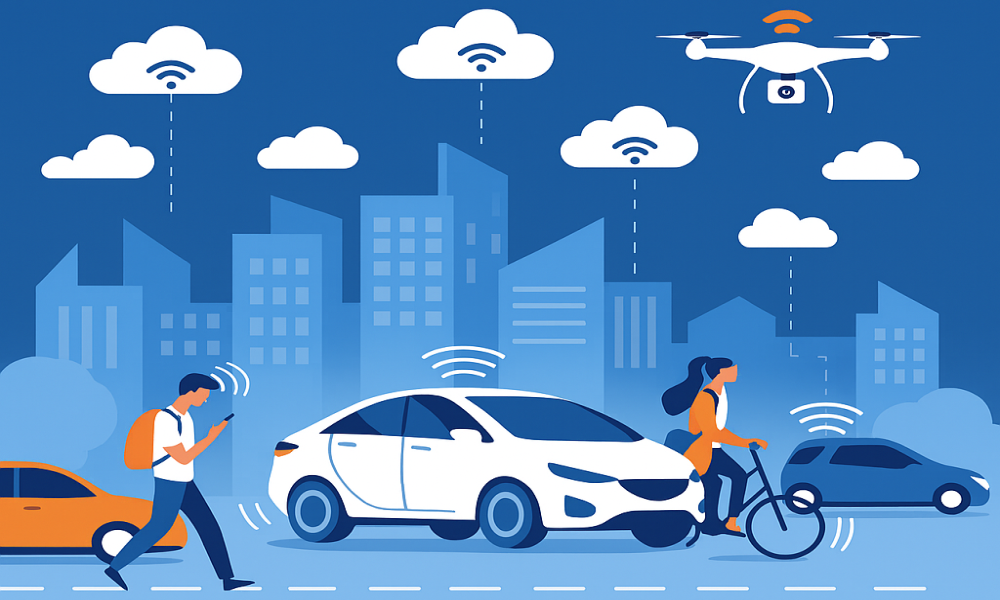
The UK transport sector stands at a pivotal moment. As Connected and Automated Mobility (CAM) and Cooperative CAM (CCAM) technologies mature, the promise of safer, cleaner and more efficient mobility is within reach. Yet, as highlighted in the latest position paper from Intelligent Transport Systems UK (ITS UK), authored in collaboration with Coventry University and leading industry experts, the path to deployment is fraught with technical, infrastructural and strategic challenges, chief among them, digital connectivity.
This article explores the key issues raised in the paper, focusing on the connectivity barriers to CAM and CCAM adoption, the role of 5G, based network slicing and the broader implications for transport stakeholders across automotive, micromobility, rail and aerial systems.
CAM and CCAM rely on seamless, ultra-reliable, low-latency communication between vehicles, infrastructure and other road users. However, the UK's existing road infrastructure is not yet equipped to support these stringent requirements. Many connectivity technologies currently deployed, such as Dedicated Short-Range Communication (DSRC) and ITS, G5, are either underutilised or being superseded by more advanced cellular solutions.
The paper identifies two dominant wireless technologies in vehicular communications:
While DSRC has been tested on UK roads through initiatives like UK CITE, its performance in high, density urban scenarios is limited. C-V2X, particularly in its 5G NR V2X variant, offers superior bandwidth and congestion management, making it more suitable for future CAM deployments.
Yet even C-V2X faces hurdles. The anticipated surge in bandwidth demand, from autonomous vehicles, augmented reality applications and drone services, poses a serious challenge to network availability and resilience. Without strategic intervention, these limitations could stall the rollout of CAM and CCAM services.
To address these challenges, the paper advocates for the adoption of 5G-based network slicing, a technique that allows mobile network operators (MNOs) to partition a single physical network into multiple virtual slices, each tailored to specific application needs.
Two slicing models are considered:

Logical slicing emerges as the preferred option for CAM and CCAM, offering a balance between performance, security and operational efficiency. However, it is not without risks. The paper warns of potential cybersecurity threats, such as Distributed Slice Mobility (DSM) attacks, which could disrupt service continuity. Robust security protocols and proactive threat mitigation strategies will be essential to safeguard these virtual networks.
The viability of 5G-V2X was recently demonstrated at the 5G Automotive Association (5GAA) Tech Demos in Berlin, where Audi and BMW vehicles successfully used 5G-V2X Direct technology to alert drivers of unseen pedestrians and cyclists. Vodafone's demo achieved sub-20 millisecond round-trip latency, showcasing the technology's readiness for safety-critical applications.
Such demonstrations underscore the transformative potential of 5G slicing, not just for CAM, but for broader transport ecosystems.
The benefits of enhanced digital connectivity extend far beyond private vehicles. The paper outlines several sectors poised to benefit:
Automotive - Improved connectivity will accelerate the adoption of CAVs across public and private transport. Mass transit solutions, such as autonomous shuttles (e.g., those trialled in the SCALE project), will become more viable. Suburban communities with limited access to traditional transport will benefit from on-demand mobility services, while private drivers will enjoy enhanced safety and route optimisation.
Micromobility - E-scooters, e-bikes and other lightweight vehicles will gain access to real-time traffic alerts and infrastructure data, enabling safer, more efficient journeys. These vehicles will also be able to broadcast their presence to nearby CAVs, augmenting onboard sensors and reducing collision risks.
Rail - Trams and light rail services will operate more safely alongside road users, thanks to improved coordination and adaptive speed control. Enhanced connectivity will reduce incident risk and improve service reliability.
Aerial Systems - Unmanned Aerial Systems (UAS), including drones and eVTOL aircraft, will play a growing role in emergency response, last, mile delivery and passenger transport. These services require robust, secure connectivity to coordinate with ground infrastructure and other airspace users, needs that 5G slicing can fulfil.
To realise these benefits, the paper calls for strategic government intervention. Key recommendations include:
Incentivising MNO investment in 5G logical slicing, particularly in underserved urban and suburban areas.
Funding scalable R&D projects that demonstrate real-world viability and offer clear rollout strategies.
Balancing long-term innovation with short-term impact, ensuring that connectivity enhancements deliver tangible benefits within realistic timeframes.
Promoting standardisation and interoperability, enabling seamless integration across transport modes and technologies.
Upskilling the workforce, particularly in telecoms and cybersecurity, to support the deployment and maintenance of advanced connectivity solutions.

The ITS UK position paper makes a compelling case for prioritising digital connectivity in the UK's transport strategy. CAM and CCAM technologies offer immense potential to reduce congestion, cut emissions and improve road safety, but only if the underlying infrastructure is fit for purpose.
5G network slicing, particularly logical slicing, presents a scalable, cost, effective solution to meet the demands of next, generation mobility. With coordinated investment, policy support and industry collaboration, the UK can lead the global race to deploy connected transport systems that are safe, efficient and inclusive.
As the transport sector evolves, connectivity will be the backbone of innovation. The time to act is now.